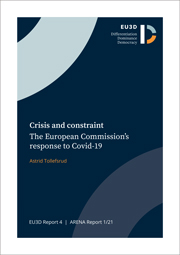 This MA report analyses how the European Commission has reacted to a global health- and economic crisis caused by the Covid-19 pandemic. The Commission has the pivotal role as the core executive EU institution with key initiating powers that run everyday administration of the EU. Responsible for policymaking, implementation and harmonisation of EU policies, this institution has had a central role in managing the Covid-19 crisis in Europe. Because the crisis quickly showed to cause serious harm on people’s health and economy, the need for coordination and appropriate measures was crucial to minimize the damages of the crisis. As EU Member States first took national measures, by closing borders and banning export of important goods, they soon realized that without collective action to beat a transboundary health threat like this, the EU would be as weak as its weakest link. The Commission, however, had limited capacities to manage the crisis as public health primarily is a Member State competence. Health policy has in the EU traditionally been developed as part of the deepening of the market rather than health as a key objective. Integration in this policy area has traditionally developed through new competition regulations. This study therefore investigates whether the Covid-19 crisis has been framed predominantly in terms of economy or health by the Commission, and how in turn this has impacted the ability of the EU for institutional change.
This MA report analyses how the European Commission has reacted to a global health- and economic crisis caused by the Covid-19 pandemic. The Commission has the pivotal role as the core executive EU institution with key initiating powers that run everyday administration of the EU. Responsible for policymaking, implementation and harmonisation of EU policies, this institution has had a central role in managing the Covid-19 crisis in Europe. Because the crisis quickly showed to cause serious harm on people’s health and economy, the need for coordination and appropriate measures was crucial to minimize the damages of the crisis. As EU Member States first took national measures, by closing borders and banning export of important goods, they soon realized that without collective action to beat a transboundary health threat like this, the EU would be as weak as its weakest link. The Commission, however, had limited capacities to manage the crisis as public health primarily is a Member State competence. Health policy has in the EU traditionally been developed as part of the deepening of the market rather than health as a key objective. Integration in this policy area has traditionally developed through new competition regulations. This study therefore investigates whether the Covid-19 crisis has been framed predominantly in terms of economy or health by the Commission, and how in turn this has impacted the ability of the EU for institutional change.
To understand how the Commission and the different actors within this institution have reacted, I use institutional theory. This qualitative case study of the Commission is therefore divided into two institutionalist categories: organisational structure and design, and institutional culture and history. By using the ‘pattern matching’ method, I analyse whether the findings correspond with the provisionary theoretical ideas. Based on the two institutional categories, I propose two different hypotheses. The first hypothesis suggests that the Covid-19 crisis has given the Commission an opportunity to change the organisational structure and design by lifting health up to EU-level. The second says the path dependency in the Commission’s response to the crisis and its way of framing health and competition limits the ability for institutional change. I find that, despite the attempts on increased capacity on EU health, through programs as EU4Health, the hegemony of the competition frame indicates that a paradigmatic shift in policies and processes in the health and economic domains seems unlikely. Competition policy, as part of the EU’s regulatory functions, is too institutionalized to change drastically.
Full info
ARENA Report 1/21 (pdf) (104 pages)
Crisis and constraint: The European Commission’s response to Covid-19
Astrid Tollefsrud
August 2021